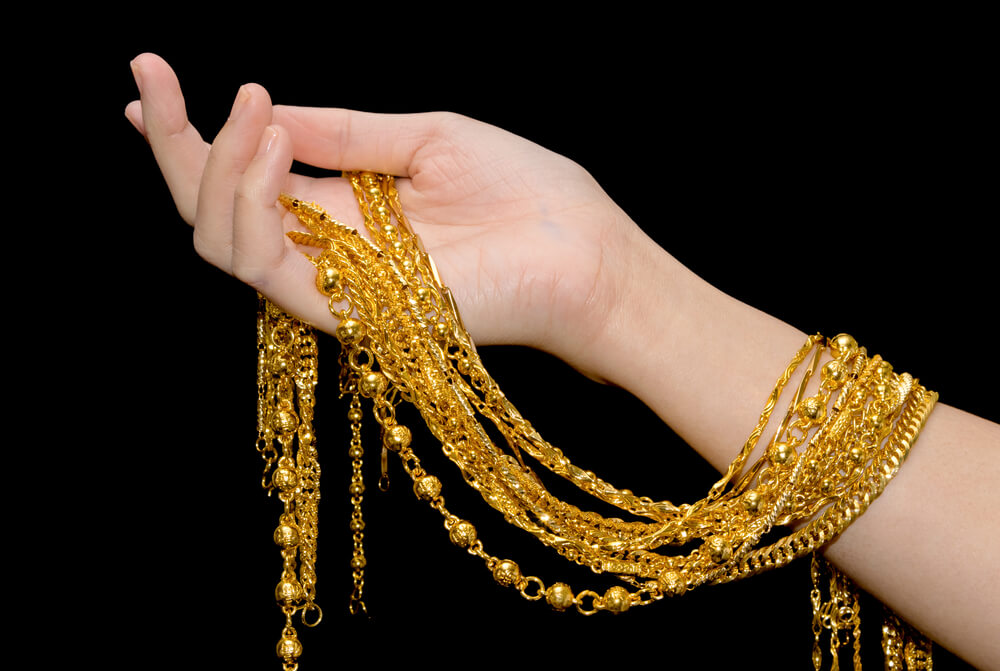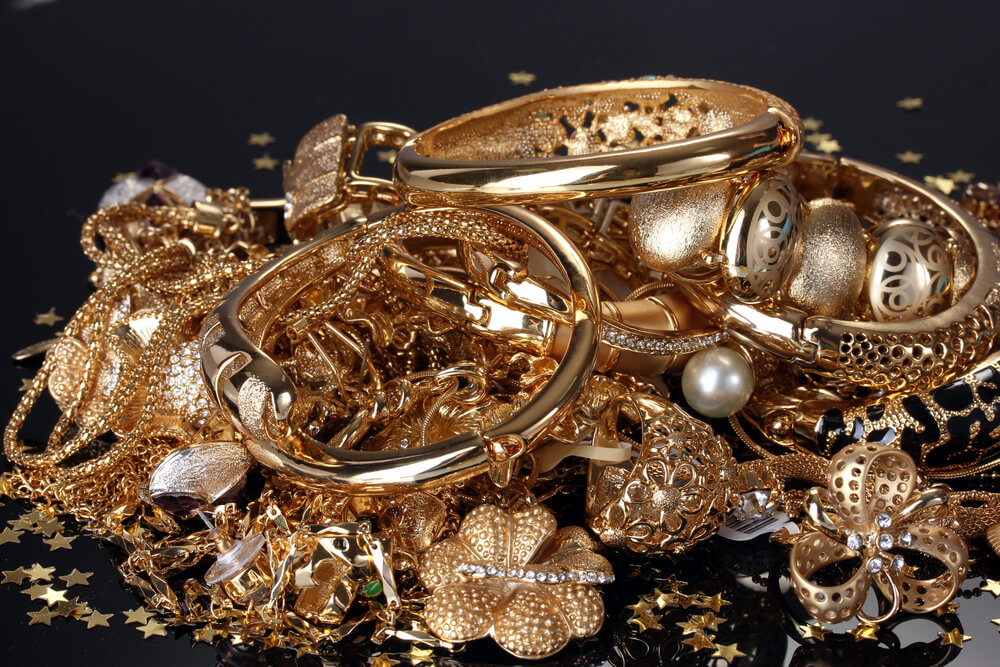
14K vs. 18K Gold: A Side-by-Side Comparison
There is pure gold. Then there are 22K, 18K, 14K, 12K, and even 10K versions of the yellow metal. The letter “K” stands for “karats,” which denotes the amount of gold in a given piece of gold jewelry. 22K gold jewelry, for instance, has 22 parts out of the total 24 parts in pure gold. The remaining two parts are other metals.
Gold is a malleable metal, and adding other metals like copper and silver to its constitution is to its benefit. A gold alloy is stronger and more resistant to wear than pure 24K gold. And then, the amalgamation serves a few other purposes, too, such as a shift in hue. If you’re out in the market to buy gold jewelry for everyday use or special occasions, a less pure form of gold is what you want, despite sounding counterintuitive.

However, the question arises, how much of the other metals should a gold alloy ideally have? Some say 22K is good. But others state 22K is too soft and that 18K is the right blend of gold and alloyed metals. Another school of thought claims 14K gold is a better option since it is relatively inexpensive and is still veritably gold.
So, which one is it? There’s no correct or best gold alloy formulation. Many gold buyers opt for 18K gold pieces, but 14K is not too far behind in the popularity race either. One thing is for sure the dilemma is usually between 14 and 18K gold.
This article will, therefore, focus on those two alloyed gold versions. We’ll discuss the two, compare them, and help you choose the right one for your needs. We’ll go over the following:
- What are 14K and 18K gold
- How are the two different from each other
- Which one should you pick from the two and more
Buying gold is not complex. But it can get confusing if you’re in the weeds focusing on karats. This article intends to make the discussion simpler and easier to assimilate. Read on to gain some clarity, particularly if you’re stuck between 14 and 18K gold.
Table of Contents
What is 14K Gold?
14K gold is a gold alloy made of 58% pure gold; the remainder is alloyed metals such as copper, silver, nickel, etc. In karat terminology, 14K gold has 14 parts out of the 24 as pure gold. Click here to learn more about gold karats and purity. 14K is one of the more durable gold blends, making the composite ideal for engagement rings or other daily-wear jewelry.
Read more: Top Gold IRA companies
What is 18K Gold?
18K is a gold alloy comprising 75% yellow gold, with the remaining 25% consisting of non-gold metals. 18K has clearly a richer gold makeup, with 18 parts out of the 24 being the purest form of gold.
For those who are wary of gold’s overtly ductility but do not want a lot of non-gold metals to infiltrate, 18K gold is preferable. 18K gold is not as durable or resistant to scratches as 14K gold, but it does a much better job than 24K gold.
The other metals in an 18K or even a 14K piece would depend on the gold alloy’s color. If it’s white gold, silver and palladium will likely have been added, with rhodium coating on top. Pink and yellow gold could have other metals added—for instance, copper.
The Differences Between 14K and 18K Gold

Both 14K and 18K gold are alloyed alloy pieces but not identical blends. Their prices and durability levels are different. The following are ways in which the two primarily differ:
Color
The discrepancy in gold content between 18K and 14K means a slight color shift. 18K gold would have a slightly richer yellow gold hue than a 14K piece. Besides assuming a slightly paler version of yellow, 14K and 18K gold could also be made to look less like gold—for instance, white or pink.
A 14K white gold jewelry tends to have a more robust white look than an 18K equivalent. But the two can be made to look the same white with rhodium plating on top. More on that later.
Similarly, 14K rose gold pieces are pinker than 18K jewelry as the lesser gold presence makes way for more copper that infuses the alloy with more pink.
Durability
Gold is a soft, malleable metal. The whole point behind mixing gold with other metals is to ward off the precious metal’s durability concerns. The greater the presence of other metals in a gold alloy, the stronger and more durable the composite will be.
Since 14K has lesser gold than 18K, it’s stronger and a more suitable alloy for engagement rings or wedding bands. Also, the added structural integrity means 14K gold wedding rings are more adept at accommodating gemstones and keeping them seated. 14K is best for individuals with an active lifestyle, who are into manual labor, or do a lot of physical work.
18K gold is pretty sturdy too, but it may not withstand regular use as much. The alloy may not bend as easily as pure gold, but it could be more prone to scratches. 18K gold jewelry is, therefore, best when worn on important events or special occasions.
| 14K | 18K | |
| Gold Percentage | 58.3% | 75% |
| Color | Warmer yellow or white; Pinkish rose gold | Whiter white; Brighter yellow; Peachier rose gold |
| Durability | Increased resistance to bending, scratches, and scuffs | Bends more easily than 14K gold and is more scratch-prone too |
| Price | Cheaper than 18K | More affordable than 24K but pricier than 14K |
Note: Although 14K gold is pretty sturdy, its rigidity is still no comparison to palladium or platinum’s robustness.
Should You Buy 14K or 18K Gold?
Both 14K and 18K gold offer benefits. But what’s right for you depends on your requirements, budget, etc. Below are things to know before deciding between 14K or 18K gold:
Price
Because 14K has less gold than 18K, it’s the more affordable alloy. Expect a price difference of close to 20%. The price disparity could be more significant or less based on the jewelry type or design.
By the way, 14K gold is not always cheaper than 18K gold. At times, the jewelry design and the studded stones could spike up the prices of a 14K piece, commanding a higher premium than your standard 18K fine jewelry piece with more pure gold. A 14K gold ring with a 3-carat diamond would cost more than engagement rings studded with smaller, more lightweight diamonds. But because 14K is cheaper, you could afford to spend more on the precious stone.
Wearing Frequency
Price alone shouldn’t determine which way you sway. You must consider durability too. If you like to wear your gold at all times and are handy with things, 14K will suit you better. But if you want more gold in your jewelry and wear gold occasionally or do not have your gold engagement ring on at work, 18K would be more up your alley.
Looks and Compatibility
Another thing to consider is the piece’s overall look and how well it complements your skin tone. If you like your gold to look more yellow, look at 18K gold. 24K gold looks more orangish than yellow. People who don’t like that in-your-face bling may fancy the subtle look of an 18K piece.
Also, yellow gold pairs well with brown, yellow, turquoise, brown, and other earthy gemstones. If you like to wear precious stones, 18K gold will complement the rocks better. Pink, blue, red, and other vibrant colored stones go well with white gold. If you like wearing colorful gemstones, look at 14K gold jewelry. But there’s no hard and fast rule here. If you fancy pairing yellow gold with a pink stone, go ahead.
Both 18K and 14K gold could be in rose, yellow, or white. The color difference between the 14K and 18K gold types is easier to discern with rose and yellow gold. However, things become tricky with white gold since the rhodium plating affords identical appearances to both 14 and 18K gold pieces. That also means both 14K and 18K white gold versions would have the same scratch-resistant capabilities.
Skin Sensitivity Concerns
Looks are subjective and can be experimented with. But certain things cannot be compromised, such as skin allergies. If you have sensitive skin or skin prone to itching or rashes, opt for 18K gold since the lesser the number of alloy metals, the lower the likelihood of skin allergies.
Nickel allergy is particularly a concern. If you have a proven past of nickel-related skin problems, ensure your 14K or 18K gold has no nickel presence. Although 18K is purer gold than 14K, it still is an alloy and, therefore, doesn’t guarantee relief from skin allergy concerns. The only exception is white gold, as the entire piece is enveloped in rhodium, one of the many skin-friendly precious metals.
Besides nickel, people can be sensitive to copper, iron, zinc, and some of the other metals added to gold.
Read more: Top 5 IRA Company Reviews
Conclusion
No wedding or engagement is complete without gold, irrespective of the customs and traditions. The gold may not be pure gold or even look the part. But the precious metal would grace the occasion in some form, shape, or color.
With this 14K vs. 18K comparison, it’s pretty clear that 14K has less gold than 18K. That, however, shouldn’t take away from the sheer brilliance and beauty of 14K gold. Both 14K and 18K gold can be made into stunning jewelry. It’s just that 18K jewels are a bit finer or more delicate pieces.
If you are not a big fan of gold’s yellow hue, consider white or rose gold in 14 or 18K avatars. And if it’s white gold that you’re more smitten by, look at platinum instead. Platinum not just looks elegant, but it’s a great form of investment too. But it’s pricey too. In this comparison between gold and platinum investments, you’ll learn more. Click on the link if you’re interested.
FAQs
Are 14K and 18K gold solid investment choices?
Although 14K and 18K gold are worth their weight in gold, they are not recommended for investment. If you’re buying gold to safeguard money, look at 24K gold bullion coins and bars instead.


